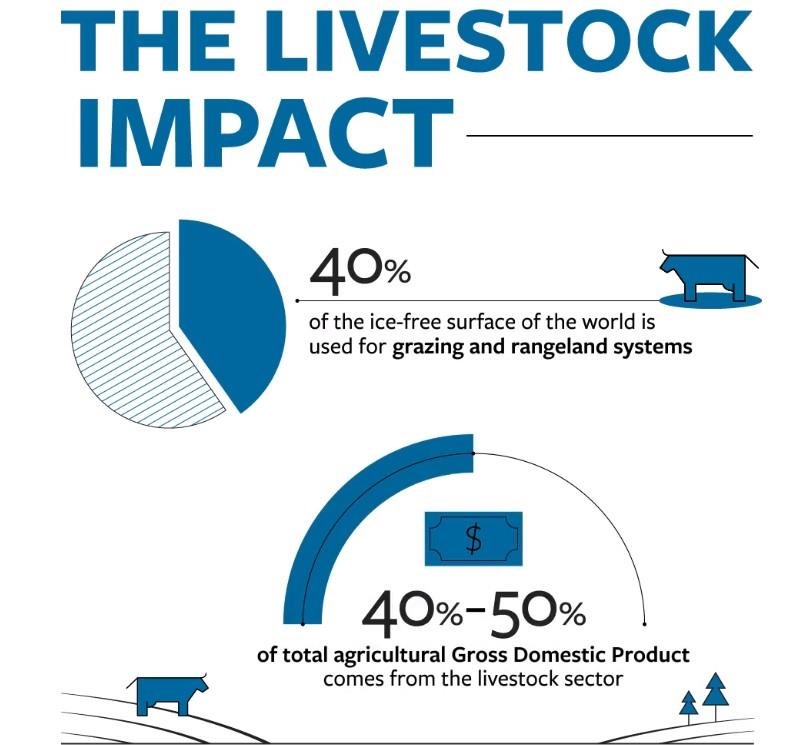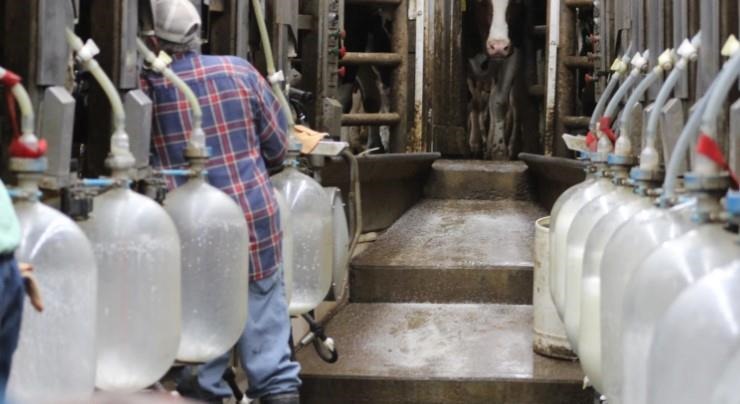By Chuck Gill
Funding of up to $25 million from the U.S. Department of Agriculture will support a new Penn State-led collaboration with dairy industry associations and producers to develop and implement climate-smart practices on Pennsylvania dairy farms. The project is aimed at generating climate commodities that add value to dairy products along the supply chain and leveraging agriculture’s potential to provide solutions to climate change.
U.S. Secretary of Agriculture Tom Vilsack visited Penn State’s University Park campus Sept. 14 to announce funding for the project and about 70 others nationwide that are part of USDA’s Partnerships for Climate-Smart Commodities initiative, which represents a total investment of as much as $2.8 billion.
“There is strong and growing interest in the private sector and among consumers for food that is grown in a climate-friendly way,” Vilsack said. “Through the Partnerships for Climate-Smart Commodities, USDA is delivering on our promise to build and expand these market opportunities for American agriculture and be global leaders in climate-smart agricultural production. This effort will increase the competitive advantage of U.S. agriculture both domestically and internationally, build wealth that stays in rural communities, and support a diverse range of producers and operation types.”

U.S. Secretary of Agriculture Tom Vilsack, second from right, is flanked by College of Agricultural Sciences Associate Dean for Research Blair Siegfried, left, and Dean Rick Roush as they listen to presentations by project leaders prior to Vilsack's announcement of funding for the Partnerships for Climate-Smart Commodities initiative. Credit: Michael Houtz, College of Agricultural Sciences. All Rights Reserved.
The project led by Penn State — titled "Climate-smart Agriculture that is profitable, Regenerative, Actionable, and Trustworthy," or CARAT — was developed in partnership with the Center for Dairy Excellence, Professional Dairy Managers of Pennsylvania, Red Barn Consulting and Proagrica.
According to project leader Armen Kemanian, professor of production systems and modeling in the College of Agricultural Sciences, the project will build on Penn State’s strengths as a source of unbiased, research-based knowledge; on the central role of dairy producers and farmer associations in implementing climate-smart practices; and on the expertise of data-driven agricultural firms to appraise and transfer the value of climate commodities along the supply chain.
“As a public, land-grant institution, Penn State will serve the role of an honest broker in the emerging value chain, documenting the value of climate-smart commodities,” he said. “This grant will enable producers to work with a team of expert consultants to help them identify, prioritize and tailor the practices to implement on their farms, measure and verify the benefits of deploying climate-smart practices, and determine market prospects for climate-smart commodities.”
Kemanian said by building partnerships among scientists, industry organizations, government agencies and dairy producers, the project can break down barriers and create new pathways to the adoption of climate-smart practices. This can be achieved, he said, by enhancing trust between producers and consumers, reducing producer skepticism by defining the cost and value of these practices, engaging underserved producers and workers across the industry, and identifying markets for climate-smart commodities.
He explained that the project team is focusing on dairy for several reasons: Dairy is a pivotal sector for Pennsylvania’s economy, with a large number of family-owned, small and medium-sized farms; there is significant potential to reduce greenhouse gas emissions via feed and nutrient management to suppress methane and nitrous oxide emissions; and, some reductions can be achieved by storing carbon in soil through reduced tillage and planting cover crops.

Researchers say there is significant potential to reduce greenhouse gas emissions in dairy production by employing feed and nutrient management practices to suppress methane and nitrous oxide emissions. Credit: Steve Williams, College of Agricultural Sciences. All Rights Reserved.
Kemanian pointed out that Penn State is at the forefront of research on greenhouse-gas reduction in agriculture and enhancing soil health for carbon capture.
“Dairies move around a lot of nutrients, which causes nitrous oxide and methane leakage, and their suppression is a tremendous opportunity to do good for agriculture and the public,” Kemanian said. “Producers want to be recognized for their efforts and for specific greenhouse-gas suppression, and we want to give consumers the chance to reward these efforts.”
Jayne Sebright, executive director of the Center for Dairy Excellence, noted that Pennsylvania’s dairy farmers have been long-time stewards of the environment.
“However, climate-smart strategies they employ on their farms must be both environmentally and economically sustainable for their businesses,” she said. “We are looking forward to this project providing financial assistance and technical resources to help our dairy farm families navigate this delicate balance, while contributing to a baseline that will allow us to set values on the contributions dairy farmers can and are making to address climate change.”
Similarly, Caroline Novak, of Professional Dairy Managers of Pennsylvania, pointed out that there are no standard benchmarks from which to quantify the value of climate-smart practices to greenhouse-gas reduction. “Our goal for the CARAT initiative is to establish real data that will better position our producers to enter into the carbon market and be assured they are being fairly compensated for their climate-smart efforts and investments,” she said.
“We know of many practices that suppress greenhouse gases,” Kemanian added, “but we need to understand specifically by how much so we can tailor the options for a particular farm. There are new technologies emerging all the time, and they need rigorous research and testing to get them into the business stream. A substantial part of the measurement and verification will occur on farms with the producers.”
Dairy producers of varying sizes and types will participate directly in the initial phase of the project across three dairy “core pockets” in distinct regions of Pennsylvania to provide a good representation of Pennsylvania’s diverse dairy farms.
“When people around the world mention American creativity and can-do attitude to meet a global challenge, we want them to think of our valleys and our farms in Pennsylvania.”
Armen Kemanian, professor of production systems and modeling, Penn State College of Agricultural Sciences
Rick Roush, dean of the College of Agricultural Sciences, noted that Pennsylvania is well positioned to take advantage of opportunities that may arise from the CARAT project.
“Pennsylvania is a leader in no-till and cover cropping, which are critical to retaining carbon in the soil,” he said, “and adoption of these practices is due in large part to research and extension programs conducted by the college in recent decades. In contrast to other states, we have a huge cohort of farmers who already are using climate-smart practices and are thus in a great place to benefit from premiums for climate-smart crops and commodities, such as corn and milk. For this reason, I was extremely enthusiastic about supporting this project.”
Kemanian suggested that the project’s success will be measured by higher agricultural production with much lower carbon intensity — and that is economically rewarded.
“Following USDA’s vision for this initiative, we hope our work leads to the emergence of socially stronger, dynamic farming communities fully integrated into the business of avoiding the build-up of greenhouse gases in the atmosphere — from farms to consumers,” he said. “When people around the world mention American creativity and can-do attitude to meet a global challenge, we want them to think of our valleys and our farms in Pennsylvania.”
Source : psu.edu